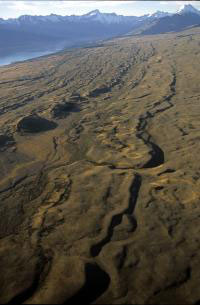New study shows much of the world emerged from last Ice Age together

Aerial view of glacial moraine (parallel lines of hills) surrounding Lake Pukaki in southern New Zealand sampled by the researchers that mark the advance of the Tasman glacier (upper left). Credit: George Denton
The Earth Institute at Columbia University, June 8, 2005–The end of the recurring, 100,000-year glacial cycles is one of the most prominent and readily identifiable features in records of the Earth's recent climate history. Yet one of the most puzzling questions in climate science has been why different parts of the world, most notably Greenland, appear to have warmed at different times and at different rates after the end of the last Ice Age.
However, a new study appearing in the upcoming issue of the journal Science suggests that, except for regions of the North Atlantic, most of the Earth did, in fact, begin warming at the same time roughly 17,500 years ago. In addition, scientists suggest that ice core records from Greenland, which show that average temperatures there did not warm appreciably until about 15,000 years ago, may have remained in a hyper-cold state largely as a result of events triggered by warming elsewhere.
The research, led by Joerg Schaefer from the Lamont-Doherty Earth Observatory, a member of The Earth Institute at Columbia University, and George Denton at the University of Maine, relied on a method known as cosmogenic or surface-exposure dating, which enabled the scientists to determine how long rock surfaces have been exposed since the glaciers retreated. As cosmic rays penetrating the Earth's atmosphere strike the scoured rock, they form an isotope of the element beryllium, 10Be, at a known rate. By measuring the minute amounts of 10Be in rock samples from glacial moraines in California and New Zealand and comparing these data to previously published results from Wyoming, Oregon, Montana Argentina, Australia and Switzerland, Schaefer and his colleagues were able to narrow down when glaciers around the world began to retreat. They found that almost everywhere they looked the glaciers began to pull back approximately 17,500 years ago. Additional studies from tropical South America southern Tibet have also produced similar results.
“It's amazing everything fits so well and that every moraine record of the last termination seems to match with rising temperature in the Antarctic and CO2 in the atmosphere,” said Schaefer, a Doherty Associate Research Scientist. “It's especially surprising because Antarctica was classically thought to be too remote and climatically isolated to respond in a synchronous manner with the rest of the planet.” The only place that does not fit the observed warming pattern is Greenland, which did not begin to emerge from the last Ice Age until roughly 15,000 years ago. The authors believe that this anomaly may be because the North Atlantic experienced continued, hyper-cold winters during the intervening 2,500 years that prevented the region from warming on average.
Glaciers, they write, are highly sensitive to summer temperatures. Instead of responding to the rise in global summer temperatures that occurred around 17,500 years ago, however, Greenland may have experienced a continued ice age climate caused by massive armadas of icebergs from the melting continental ice sheets on North America and Northern Europe spreading across the North Atlantic. The freshwater from the melting icebergs likely caused an ocean current known as the meridonal overturning circulation, which transports heat northward from the equator, to almost cease and prevent Greenland and the North Atlantic from warming for millennia after the rest of the planet had begun to do so.
“The spreading sea ice would have also brought the circum-polar winds farther south,” said Schaefer. “This would have interfered with temperature and precipitation patterns in the northern mid-latitudes and put the North Atlantic in the deep freeze for 2,500 years.”
Media Contact
More Information:
http://www.earth.columbia.eduAll latest news from the category: Earth Sciences
Earth Sciences (also referred to as Geosciences), which deals with basic issues surrounding our planet, plays a vital role in the area of energy and raw materials supply.
Earth Sciences comprises subjects such as geology, geography, geological informatics, paleontology, mineralogy, petrography, crystallography, geophysics, geodesy, glaciology, cartography, photogrammetry, meteorology and seismology, early-warning systems, earthquake research and polar research.
Newest articles

Scientists transform blood into regenerative materials
… paving the way for personalized, blood-based, 3D-printed implants. Scientists have created a new ‘biocooperative’ material based on blood, which has shown to successfully repair bones, paving the way for…

A new experimental infection model in flies
…offers a fast and cost-effective way to test drugs. Researchers at the Germans Trias i Pujol Research Institute and Hospital have reinforced their leading role in infectious disease research by…

Material developed with novel stretching properties
KIT researchers produce metamaterial with different extension and compression properties than conventional materials. With this material, the working group headed by Professor Martin Wegener at KIT’s Institute of Applied Physics…



